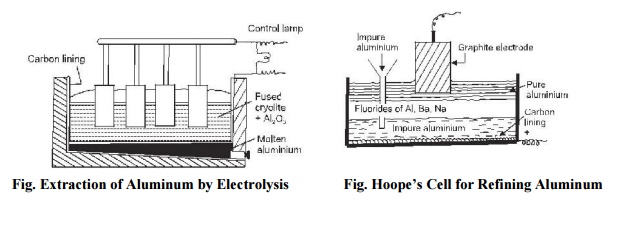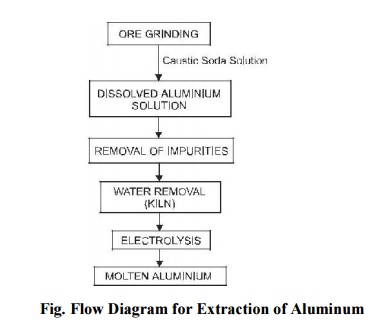Chapter: Civil : Construction Materials: Timber And Other Materials
Aluminum

Aluminum
The principal constituents of
bauxite (Al2O32H2O) which yield aluminum on a
commercial scale are hydrated oxides of aluminum and iron with some silica.
Some of the other aluminum ores are
corundum, kaolin or china clay, and kryolite. The ore is purified by
Bayer's process and is reduced to aluminum by
Hall Hiroult's process in two stages. In the first stage bauxite is
converted into alumina by roasting, grinding, heating (with sodium hydrate) and
filtering. Then it is agitated for several hours to precipitate the hydrate,
which is separated, washed, and calcined at 1000 o C. In the next stage aluminum
is extracted by electrolysis of alumina in a molten bath (Fig. 14.1) of
crystolite (a fluoride of alumina and sodium). A flow diagram for extraction of
aluminium is shown in Fig.

Aluminum is silver white in
colour with a brittle metallic lustre on freshly broken surface. It is
malleable, less ductile than copper but excels zinc, tin, and lead. Aluminium
is harder than tin. Aluminium is very light, soft, strong and durable, has low
thermal conductivity but is a good conductor of electricity. Aluminium can be
riveted and welded, but cannot be soldered. It can be tempered at 350 o C. The
melting point is 657 o C, tensile strength is 117.2 N/mm2 in the cast
form and 241.3 N/mm2 when drawn into wires. Aluminium is found to be
resistant to the attack of nitric acid, dissolves slowly in concentrated
sulphuic acid and is soluble in hydrochloric acid. At normal temperature it is
not affected by sulphur, carbonic acid, carbonic oxide, vinegar, sea water,
etc., but is rapidly corroded by caustic alkalis.
Uses Pure
aluminum is very soft and is unsuitable for structural purposes. Satisfactory
properties are derived by alloying copper, manganese, zinc, silicon, nickel
with aluminum. It is most suitable for making door and window frames, railings
of shops and corrugated sheets for roofing system. Aluminum sheets are used
over doors in bathrooms to protect them from getting rot and for stamping into
a variety of shapes. Aluminum powder is used for making paint. Aluminum is
extensively used in making parts of internal combustion engine, airplanes,
utensils and packing for medicines, chocolates, etc. Aluminum alloys are widely
used for the manufacture of rolled sections, such as angles, channels,
I-sections, round and rectangular pipes, rivets, and bolts

Alloys
Aluminum
is commonly alloyed with copper silicon, magnesium, or zinc to improve its
mechanical properties. Some aluminum alloys also contain one or more of the
metals manganese, lead, nickel, chromium, titanium, and beryllium. A large part
of the aluminum production is utilized in making light, stiff,
corrosion-resistant alloys with these metals. Aluminum alloys may be classed as
the cast alloys, which are shaped by casting and wrought alloys, which are
worked into different shapes by mechanical operations. Cast alloys are generally
binary alloys containing copper or silicon, and sometimes magnesium. Wrought
alloys contain copper, magnesium, silicon, and manganese that form
precipitation hardening alloys with aluminum. Following are some of the
aluminum alloys.
Duralumin contains
3-5%
copper, 0.51-1% magnesium and 0-0.07%
manganese. 0.3-0.6% iron and 0.3%-0.6%
silica are present as impurities. The relative density is 2.80, which is quite
low as compared to that of mild steel. However, when rolled and heat treated
tensile strength equals that of mild steel. Its yield point is 206.85 N/mm2.
It is highly resistant to corrosion. Wire and sheets are drawn from duralumin.
Duralumin may be fabricated into different structural shapes to be used for
construction.
Magnesium is an
alloy of aluminum and magnesium (6 per cent). It has got very good mechanical
properties and is a little lighter than pure aluminum. It is easy to work,
exceptionally strong, and ductile and is widely used as deoxidizers in copper
smelting operations.
Aldural When a
coating of aluminum is given to duralumin it is known as aldural and has
better corrosion resisting properties.
Y-alloy invented
during World War II contains 4 per cent copper, 20 per cent nickel and
1.5 per cent magnesium. Toughness and hardness are achieved by heating it to
500 o C for six hours and then cooling it down in boiled water. Its relative
density is 2.80 and resists corrosion better than duralumin. Y-alloy has good
thermal conductivity and can sustain high temperature. It is used for making
pistons of I.C. engines, cylinder head, connecting rod and propeller blades.
Aluminium Bronze contains
less than 11 per cent of aluminium and is rather inappropriately named.
It is highly ductile when aluminium is less than 7.3 per cent. As the aluminium
increases, ductility decreases and at 12 per cent the alloy is very brittle.
Bronzes containing less than 7.3 per cent aluminium are highly resistant to
torsional stress, readily rolled, forged, cold drawn, exhibit toughness under
impact and resistance to alternate bending stress.
An input of 1 per cent of
maganese into 10 per cent aluminum bronze increases the yield point and
ductility without change in strength or endurance under reversal of stress. The
modulus of elasticity of aluminium bronze is about 1.03425 × 10 5
N/mm2. These are almost incorrodible in sea water and in this
respect are superior to Muntz metal or naval brass.
Aluminium bronze is used for pump
lines, tubes, springs, screws, rivets, ornamental works, marine engineering
castings, motor boat shafting, musical instruments, and as a substitute of mild
steel to resist corrosion, grill works, etc.
Light
Alloy contains 3 per cent copper and 12 per cent zinc. It is used
for castings such as crank and gear housings. Aluminium-Copper Alloy
contains copper up to 4 per cent. Less liable to burning the alloy produces
light castings that are stronger and tougher than that made from aluminium. It
is mainly used in automobile industry for casting.
Aluminium-Zince Alloy contains
zince up to 15 per cent and is used for light casting which can be
easily machined or forged into desired form. These are very sensitive to high
temperatures in melting and in solid form exhibit low strength and brittleness
when heated above 50 o C. Alloys containing 15 to 25 per cent zinc are harder,
stronger, but less ductile and more difficult to roll or draw. If percentage of
zinc is increased above 25 the alloy suffers decrease in strength when
excessively worked, either hot or cold. Aluminium zinc alloys have well defined
yield points. Aluminium-Silicon Alloy Aluminium alloys containing
5 to 15 per cent silicon are important because their excellent casting
qualities, including excellent fluidity and freedom from hot-shortness, permit
the pouring of thin intricate sections. They also have high resistance to
corrosion, are good conductors of heat, and have low thermal expansion
Aluminium composite panel (ACP)
also aluminium composite material, (ACM) is a type of flat
panel that consists of two thin aluminium sheets bonded to a non-aluminium
core. ACPs are frequently used for external cladding or facades of buildings,
insulation, and signage.[3]
Aluminium sheets can be coated
with polyvinylidene fluoride (PVDF), fluoropolymer resins (FEVE), or polyester
paint. Aluminium can be painted in any kind of colour, and ACPs are produced in
a wide range of metallic and non-metallic colours as well as patterns that imitate
other materials, such as wood or marble. The core is commonly low density
polyethylene, or a mix of low density polyethylene and mineral material to
exhibit fire retardant properties.
3A Composites (formerly Alcan
Composites & Alusuisse) invented aluminium composites in 1964 and
commercial production of Alucobond commenced in 1969, followed by Dibond 20
years later.
1 Applications
Sandwich panels are used in those
applications where high structural rigidity and low weight is required. An
evident example of use of sandwich panels is aircraft where mechanical
performance and weight saving is essential. Other applications include
packaging (e.g. fluted polypropylene boards of polypropylene honeycomb boards),
transportation and automotive as well as building & construction.
ACP is mainly used for external
and internal architectural cladding or partitions, false ceilings, signage,
machine coverings, container construction etc. Applications of ACP are not
limited to external building cladding, but can also be used in any form of
cladding such as partitions, false ceilings etc. ACP is also widely used within
the signage industry as an alternative to heavier, more expensive substrates.
Epcot's
Spaceship Earth is an example of the use of ACP in architecture. It is a
geodesic sphere composed of 11,324 ACP tiles.
ACP has been used as a
light-weight but very sturdy material in construction, particularly for
transient structures like trade show booths and similar temporary elements. It
has recently also been adopted as a backing material for mounting fine art
photography, often with an acrylic finish using processes like Diasec or other
face-mounting techniques. ACP material has been used in famous structures as
Spaceship Earth, VanDusen Botanical Garden, the Leipzig branch of the German
National Library.
These structures made optimal use
of ACP through its cost, durability and efficiency. Its flexibility, low weight
and easy forming and processing allow for innovative design with increased
rigidity and durability.
2 Other names
Many people use Alucobond
or sandwich panel as a generic name (genericized trademark) for aluminum
composite panels that are typically 0.3 to 0.5 mm thick aluminum sheets
covering a solid polyethylene core with a total thickness of 3 mm or more, or
similar panels from any manufacturer.[9]
A variety of manufacturers sell
aluminium composite panels under a wide variety of brand names, including: (in
no particular order)
Alucobond from 3A Composites,
ALPOLIC from Mitsubishi Plastics, Aluminum wall claddings from Guangzhou Xinghe
Aluminum Co, Ltd Reynobond from Alcoa, Envelope 2000 from CitadelAP, Aludecor
from HMB Group, Larson from Alucoil, Hylite from 3A Composites, VillaBOND from
Villa Bond, Dibond from 3A Composites and Alcan, WILLSTRONG from WILLSTRONG CO.
Max-Metal from Grimco, RedBond from aRedBond Composites, Vitrabond from
Fairview Architectural, Plascore Board from Plascore, Alupanel and Alupanel XT
are manufactured by Multipanel UK in their own UK factory, Etalbond from Elval
Colour, AlubondAfrica, Pink Rhino from Pettongtana etc.
Some people
use sandwich panel
for any structural
sandwich (sandwich-
structured composite) of a core
bonded between two cover sheets, no matter what material(s) it is made of, and
no matter if the core is solid, foam, flutes, or honeycomb.[10]
3 The selective use of ACP
An important aspect to discuss
here is the haphazard use of ACP, a trend for which the user is responsible and
not the material. One can witness the use of ACP in newly constructed buildings
in areas of historic importance without any regard to the built environment of
the place thus ruining the architectural, historic and cultural fabric of the
place.
It can be argued that ACP is a
stylish and sensible innovation, which can prove to be a blessing for
commercial as well as decorative purposes. Yet one should be aware of its
benefits as well as demerits, and also realize its installation process and
features. This would result in the proper use of the material instead of the
haphazard nature of its current introduction into the buildings in the city.
Paint is a liquid surface
coating. On drying it forms a thin film (60-150 m) on
the painted surface. Paints are classified as oil paints, water paints, cement
paints, bituminous paints and special paints such as fire proof paints,
luminous paints, chlorinated rubber paints (for protecting objects against acid
fumes), etc.
The functions of the paints are:
to protect the coated surface against possible stresses-
mechanical or chemical; deterioration-physical
or environmental; decorate the structure by giving smooth and colourful finish;
check penetration of water through R.C.C; check the formation of bacteria and
fungus, which are unhygienic and give ugly look to the walls; check the
corrosion of the metal structures; check the decay of wood work and to varnish
the surface to display it to better advantage.
Related Topics